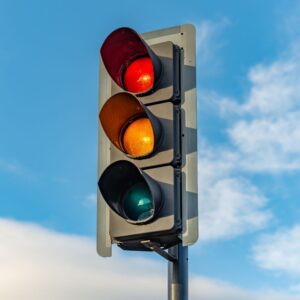Picture this: The line of vehicles in front of you is finally crawling forward. It’s been a long day and you can’t wait to get home. Just as you reach the front of the line though, the traffic light at the intersection goes from green to yellow to red. It’s a familiar but irritating experience, and one that might make you wonder how traffic lights work in the first place. Is it a matter of luck, or are traffic lights controlled by more than just timers?
Are Traffic Lights Sensored or Timed?
A modern traffic light is a computer of sorts. Many models have a nearby control box and can also be remotely controlled. Traffic lights in various areas operate differently. Suburbs and country roads often have traffic light sensors or detectors. This is to manage the more inconsistent traffic flow in these areas. Sensor-dependent traffic lights can detect when vehicles are stacked at a certain intersection, when those vehicles enter turn lanes, and when they arrive at intersections.
In larger cities, traffic lights are more often dependent on traffic light timers controlled by the state department of transportation, the city, and the county. In cities of more than 50,000 people, local governments own and maintain traffic signals.
How Does Syncing Traffic Lights Work?
For the most part, timed traffic signals rely on what’s called a pre-timed system. For example,traffic lights in the city of Minneapolis run on a 100-second cycle that covers the entire cycle from green light to yellow light to red light. Each intersection also works in unison with all the other intersections in the city. The whole grid system adjusts traffic light times according to the pre-timed system.
Some cities have timing programs for different times of day, such as morning and evening rush hour. Whoever’s in charge of the timed traffic signals needs to take into account factors like heavy lunch hours and unique weekend patterns. Some cities reevaluate traffic light timing every three to five years. They also do so when the need arises, like when new developments are built in the area or when there are multiple complaints about a particular light.
There are even cities, like LA, that measure traffic flow using cameras and sensors. Their traffic control center makes adjustments to the traffic lights in real time to keep traffic moving efficiently. Traffic lights are still on a timer, but the timer adjusts accordingly.
Is Syncing Traffic Lights Effective?
Using proper traffic signal management results in a ton of improvements, including better air quality, reduced congestion and fuel consumption, fewer accidents, and more. Unfortunately, while syncing traffic signals definitely helps improve congestion, it’s often not as effective as many commuters would like.
Synced traffic signals work well when it’s easy to predict traffic flow. Pre-timed systems can account for morning and evening rush hours, providing more traffic-heavy lanes with longer green lights during that time. Unfortunately, traffic patterns tend to vary, and they won’t always follow the predicted scenarios.
Why Aren’t More Traffic Lights Synced?
Timing traffic lights is an expensive process. It can cost a city between $3,500 and $4,000 per intersection. Not just that, there are also jurisdiction issues to consider since some stretches of road pass through different municipalities. As a result, some cities have gone far longer than three to five years without syncing their traffic lights.
Now you know how traffic lights are timed and why it can take so long for cities to sync them correctly. While there’s no question that traffic lights have come a long way, there’s still a lot to do before they can reach peak efficiency.
Any information provided on this Website is for informational purposes only and is not intended to replace consultation with a professional mechanic. The accuracy and timeliness of the information may change from the time of publication.























